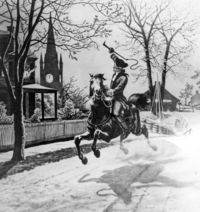Tomorrow will be the 241st anniversary of the Declaration of Independence. The war for Independence started over a year before on April 18th, 1775, when British troops marched on Lexington and Concord. Paul Revere, was made famous by his ride to try and warn the Minutemen that they were coming. He was joined by two others that night, Samuel Prescott, and William Dawes who still lie in historical obscurity. Why? Because of a poem with wonderful entertainment value, “Paul Revere’s Ride” by Longfellow.
Listen my children and you shall hear
Of the midnight ride of Paul Revere,
On the eighteenth of April, in Seventy-five;
Hardly a man is now alive
Who remembers that famous day and year.
It is a gripping good poem and ripping good yarn but it is not true. The truth is that Revere never finished his ride because the British captured him. Dawes was thrown from his horse and never finished the ride. Prescott made it to Concord and did his duty.
Another man had taken off earlier and was charged with warning Philadelphia that the British were on the March. His name was Israel Bissell and he covered about 350 miles in 4 and half days, killing one horse on the way.
There was another midnight rider and her name was Sybil Ludington. She made her journey on April 26, 1777, The daughter of Colonel Henry Ludington, Sybil, at the young age of sixteen, would make a journey double to that of Revere (totaling 40 miles) to warn the colonists at Danbury, Connecticut of the approach of the British.
History as they say is written by the winners. It is also written by those who have a narrative to tell. It can be written by those who need to rhyme a word with “hear”. “Listen my children and you shall hear of the midnight ride of Samuel Prescott doesn’t work”.


